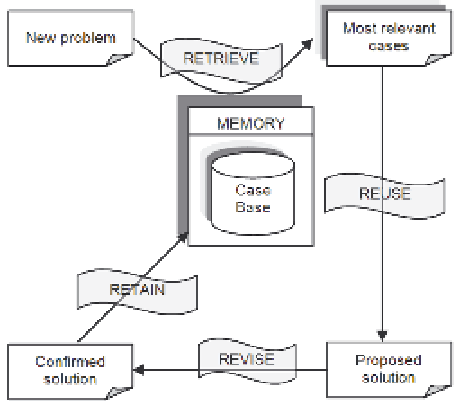Information Technology Reference
In-Depth Information
cases, each of which represents a problem together with its corresponding solution. Once a
new problem arises, a possible solution to it is obtained by retrieving similar cases from the
case base and studying their recorded solutions. A CBR system is dynamic in the sense that,
in operation, cases representing new problems together with their solutions are added to the
case base, redundant cases are eliminated and others are created by combining existing
cases.
Every time a CBR system copes with a new problem situation, retrieves previously stored
cases together with their solutions, matches them against the new problem context, adapts
previous outcomes to provide an answer to the new problem and stores the new solution by
adding a novel case in the case base. All of these actions are self-contained and can be
represented by a cyclic sequence of processes (see Figure 1) in which human interaction may
be needed. A typical CBR system is composed of four sequential steps which are called into
action each time a new problem is to be solved (Watson, 1997; Kolodner, 1993; Aamodt &
Plaza, 1994): (
i
)
retrieve
the most relevant case(s) (
ii
)
reuse
the case(s) in an attempt to resolve
the problem, (
iii
)
revise
the proposed solution if necessary and (
iv
)
retain
the new solution as
a part of a new case.
Fig. 1. Typical CBR life cycle comprising four stages
Each of the steps comprising the CBR life cycle defined in Figure 1 requires a model or method
in order to accurately perform its mission (see Figure 2). The purpose of the retrieval step is to
search the case base and select one or more previous cases that most closely match the new
problem situation, together with their solutions. The selected cases are reused to generate a
solution appropriate to the current problem situation. This solution is revised if necessary and
finally, the new case (i.e. the problem description together with the obtained solution) is stored
in the case base. In the CBR cycle there is normally some human interaction. Whilst case
retrieval and reuse may be automated, case revision and retention are often undertaken by
human experts. This is a current weakness of CBR systems and one of their major challenges.
As showed in Figure 2, the techniques commonly used for implementing the different stages
of a typical CBR system include: knowledge-based systems, artificial neural networks (ANN),
genetic algorithms (GA), rule-based systems (RBS), qualitative reasoning (QR), fuzzy systems
(FS) and constraint satisfaction problems (CSP).


Search WWH ::

Custom Search